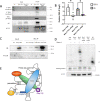The methyl phosphate capping enzyme Bmc1/Bin3 is a stable component of the fission yeast telomerase holoenzyme
- PMID: 35277511
- PMCID: PMC8917221
- DOI: 10.1038/s41467-022-28985-3
The methyl phosphate capping enzyme Bmc1/Bin3 is a stable component of the fission yeast telomerase holoenzyme
Abstract
The telomerase holoenzyme is critical for maintaining eukaryotic genome integrity. In addition to a reverse transcriptase and an RNA template, telomerase contains additional proteins that protect the telomerase RNA and promote holoenzyme assembly. Here we report that the methyl phosphate capping enzyme (MePCE) Bmc1/Bin3 is a stable component of the S. pombe telomerase holoenzyme. Bmc1 associates with the telomerase holoenzyme and U6 snRNA through an interaction with the recently described LARP7 family member Pof8, and we demonstrate that these two factors are evolutionarily linked in fungi. Our data suggest that the association of Bmc1 with telomerase is independent of its methyltransferase activity, but rather that Bmc1 functions in telomerase holoenzyme assembly by promoting TER1 accumulation and Pof8 recruitment to TER1. Taken together, this work yields new insight into the composition, assembly, and regulation of the telomerase holoenzyme in fission yeast as well as the breadth of its evolutionary conservation.
© 2022. The Author(s).
Conflict of interest statement
The authors declare no competing interests.
Figures






Similar articles
-
The fission yeast methyl phosphate capping enzyme Bmc1 guides 2'-O-methylation of the U6 snRNA.Nucleic Acids Res. 2023 Sep 8;51(16):8805-8819. doi: 10.1093/nar/gkad563. Nucleic Acids Res. 2023. PMID: 37403782 Free PMC article.
-
A putative cap binding protein and the methyl phosphate capping enzyme Bin3/MePCE function in telomerase biogenesis.Nat Commun. 2022 Feb 25;13(1):1067. doi: 10.1038/s41467-022-28545-9. Nat Commun. 2022. PMID: 35217638 Free PMC article.
-
Pof8 is a La-related protein and a constitutive component of telomerase in fission yeast.Nat Commun. 2018 Feb 8;9(1):587. doi: 10.1038/s41467-017-02284-8. Nat Commun. 2018. PMID: 29422664 Free PMC article.
-
Single-Run Catalysis and Kinetic Control of Human Telomerase Holoenzyme.Adv Exp Med Biol. 2022;1371:109-129. doi: 10.1007/5584_2021_676. Adv Exp Med Biol. 2022. PMID: 34962637 Free PMC article. Review.
-
Structural biology of human telomerase: progress and prospects.Biochem Soc Trans. 2021 Nov 1;49(5):1927-1939. doi: 10.1042/BST20200042. Biochem Soc Trans. 2021. PMID: 34623385 Free PMC article. Review.
Cited by
-
Post-Transcriptional and Post-Translational Modifications in Telomerase Biogenesis and Recruitment to Telomeres.Int J Mol Sci. 2023 Mar 6;24(5):5027. doi: 10.3390/ijms24055027. Int J Mol Sci. 2023. PMID: 36902458 Free PMC article. Review.
-
The fission yeast methyl phosphate capping enzyme Bmc1 guides 2'-O-methylation of the U6 snRNA.Nucleic Acids Res. 2023 Sep 8;51(16):8805-8819. doi: 10.1093/nar/gkad563. Nucleic Acids Res. 2023. PMID: 37403782 Free PMC article.
-
Drosophila Amus and Bin3 methylases functionally replace mammalian MePCE for capping and the stabilization of U6 and 7SK snRNAs.Sci Adv. 2023 Dec 15;9(50):eadj9359. doi: 10.1126/sciadv.adj9359. Epub 2023 Dec 15. Sci Adv. 2023. PMID: 38100593 Free PMC article.
-
Telomerase structural biology comes of age.Curr Opin Struct Biol. 2022 Oct;76:102446. doi: 10.1016/j.sbi.2022.102446. Epub 2022 Sep 6. Curr Opin Struct Biol. 2022. PMID: 36081246 Free PMC article. Review.
-
Catalytic activity of the Bin3/MePCE methyltransferase domain is dispensable for 7SK snRNP function in Drosophila melanogaster.Genetics. 2024 Jan 3;226(1):iyad203. doi: 10.1093/genetics/iyad203. Genetics. 2024. PMID: 37982586 Free PMC article.
References
MeSH terms
Substances
LinkOut - more resources
Full Text Sources
Molecular Biology Databases
Research Materials

